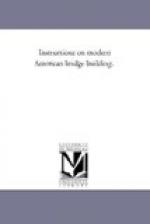Iron Bridging is gradually working its way into favor, and Will probably eventually supersede wooden trusses;—but in many cases wood is the only material at hand—and therefore some knowledge of Wooden Bridging is desirable. It is intended to follow this pamphlet with a portfolio of sheets containing working drawings of several kinds of Wooden Bridges, taken from actual measurements of some of the best specimens of the different styles of Truss in use.
* * * * *
=PRACTICAL NOTES.=
When putting a truss together in its proper position, on the abutments, ‘false works’ must first be erected to support the parts until they are so joined together as to form a complete self-sustaining truss. The bottom chords are first laid as level as possible on the false works, then the top chords are raised on temporary supports, sustained by those of the lower chord, and are placed a few inches higher at first than their proper position, in order that the web members may be slipped into place. When this is done the top chords are gradually lowered into place. The screws are then gradually tightened, (beginning at the centre and working towards both ends,) to bring the surfaces of the joints into proper contact, and by this method, the camber forms itself, and lifts the lower chords clear of the false works, leaving the truss resting only upon its proper supports. The subjoined Table will be found useful in estimating the strains on a truss when proportioning a bridge for any moving load.
Table of weights per running foot of a bridge, (either of wood or iron,) including weights of floor, lateral bracing, &c., complete, for a single track.
Clear Weight of
Span. Bridge.
Tons. lbs.
25 .266 596 30 .281 629 40 .313 701 50 .343 768 60 .374 838 70 .404 905 80 .434 972 90 .464 1039 100 .494 1106 120 .554 1241 140 .614 1375 150 .643 1440 160 .673 1507 170 .703 1575 180 .733 1642 200 .792 1774 225 .867 1942 250 .940 2105 275 1.013 2269 300 1.087 2435
The weight of a single track railway bridge may be taken as equal to that of a double track highway bridge,—and the trusses that will be large enough for one will be large enough for the other.
The greatest load that a highway bridge can be subjected to is 120 lbs. to the square foot of surface.
TABLE OF CAMBERS FOR BRIDGE TRUSSES.
Span. Camber. Span.
Camber. Span. Camber. Span.
Camber.
feet. Inches. Feet.
Inches. Feet. Inches. Feet.
Inches.
25 0.8 75 2.5 175 5.8 275 9.2 30 1.0 100 3.3 200 6.7 300 10.0 50 1.7 120 4.0 225 7.5 325 10.8 60 2.0 150 5.0 250 8.3 350 11.7
TRAUTWINE’S TABLE FOR FINDING INCREASE IN
LENGTH OF UPPER CHORD BEYOND THE
LOWER CHORD ON ACCOUNT OF THE CAMBER.




